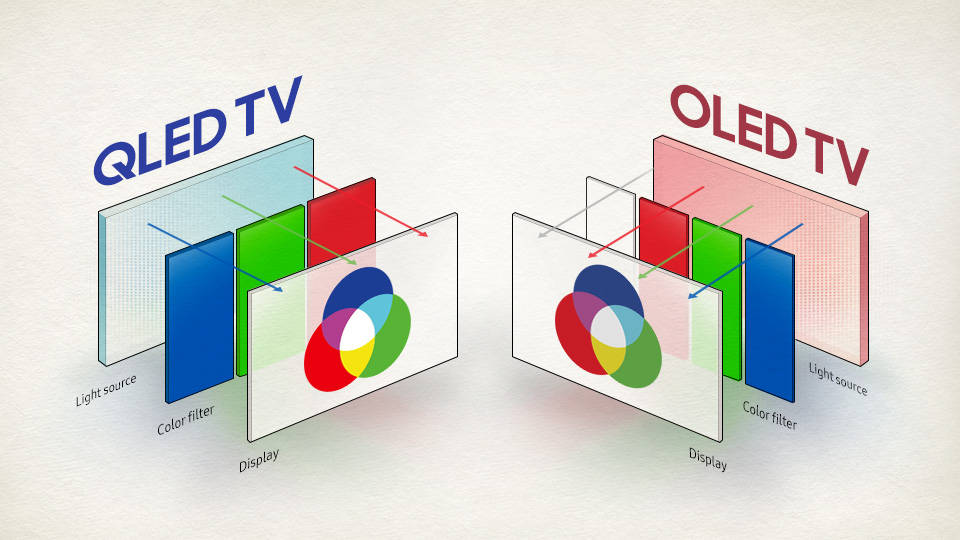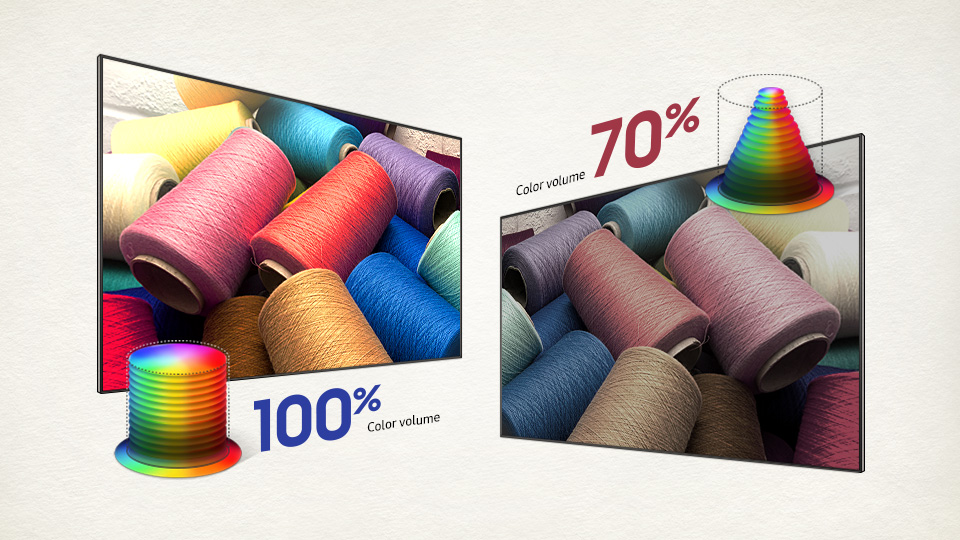QLED TV vs. OLED TV
QLED TV and OLED TV. Sounds similar, right? And they are, in a sense. For Samsung, QLED TV means TV that uses Quantum dots to produce pure colour by passing LED light through Quantum dot colour filters. And OLED TV uses organic LED as a light source and passed it through regular colour filters to produce colour. OLED is different from AMOLED used on smartphone screens.* Both “QLED” and “OLED” are used in terms of TV technology. But that’s where the similarities end—they provide a completely different viewing experience. We thought we’d put these two in the ring together and see who emerges victorious as Champion of TV. (*OLED TV comparisons are based on TV models released prior to 2017 and are not referring to any specific model.)

Round One: True RGB
All TVs use red, green, and blue as the base colours to create the images you see on screen, and when you turn on the TV, you expect the colours to come in correctly. However, the way different kinds of TVs produce those colours varies, and can result in true colours or not-so-realistic colours. Because the size of the Quantum dot determines the colour it produces, QLED TV is able to separately depict accurate red, green, and blue. So QLED TVs use true RGB to produce pure colour, providing lifelike hues. OLED TVs use WOLED panels to produce colour. The W stands for white, which ends up getting mixed in with red, green, and blue, resulting in colours that aren’t as pure.

Round Two: Colour Volume
Colour volume is what occurs when light is shone through colour, resulting in a bright-to-dark spectrum of every colour. The better the colour volume in a TV, the closer to life the colours appear. QLED TV can express nearly all of the colours in the DCI-P3 colour space, and of those colours, express 100% of the colour volume, thereby producing an incredible range of colours.‡
But with OLED TV, when the image is too bright, the percentage of the colours in the colour volume produced by the TV drops significantly. The colours get washed out and can only express around 70% colour volume, making the picture quality drop too.

Round Three: HDR
If a villain’s lurking in the dark, you want to be able to see them, right? But you also don’t want to strain your eyes to see them, making your eyes hurt after a scary movie binge! QLED TV uses HDR, or High-Dynamic Range, to achieve a brightness level between HDR 1500 to HDR 2000, or the equivalent of 1500 to 2000 candles. This is like the level of brightness that we see in the real world and because it matches what our eyes see in the world, it’s optimized for our viewing comfort. But even with a much higher level of brightness, QLED TV expresses an incredible amount of detail. In comparison, OLED TV’s brightness level is only half of what QLED TV can achieve, and as a result, details get lost.

Round Four: Lifespan
A TV is a big purchase, and since it becomes the focal entertainment point of the household, it’s a purchase that should last you and your family a long time. The New Metal Quantum dot is improved over previous Quantum dots, and is coated four times to protect from outside elements. They’re also made of an inorganic material, and the stability of New Metal Quantum dots means that QLED TV gives you consistent colour expression throughout its long lifespan. OLED TV uses organic material, so it loses colour expression as it ages.

Round Five: Burn-in
Burn-in is a permanent discoloration of your TV screen due to a static image being left on screen for a long time, and it’s totally disappointing when your TV experience is marred because of it. A TV that doesn’t burn in will offer a long period of enjoyment. And because Quantum dots are an inorganic material they have little risk of burn-in, even at maximum brightness.
But OLED TVs aren’t made to watch at maximum brightness, because, in combination with the organic material that comprises OLED TV, it increases the risk of burn-in. So you have to choose between a bright screen for better colour expression or burn-in.
Well folks, both players put up a good fight but when it comes to the title Champion of TV, there’s little doubt that QLED TV has come out the victor!
- * In this post, OLED TV refers to a TV using WOLED panels to produce colour.
- † OLED TV comparisons are based on TV models released prior to 2017 and are not referring to any specific model.
- ‡HDR colour volume results are based on the ICDM test method carried out by VDE.
- The illustrated graphics in this post are for comprehension purpose only.
Products > TV & Audio
For any issues related to customer service, please go to samsung.com/za/support for assistance.
For media inquiries, please contact ssapr.newsroom@samsung.com.